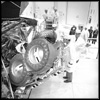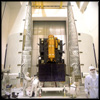|

|
1968. The 103 Apollo Command/Service Module is shown being mated to
the Instrument Unit atop the three-stage Apollo/Saturn 503 Launch Vehicle
inside the Vehicle Assembly Building.
|
|

|
1969. The Apollo 11 Command/Service Module is being mated to the Saturn
V Lunar Module Adapter.
|
|

|
1971. Apollo 16 Commander, John Young, center; and Lunar Module Pilot
Charles Duke, foreground, inspect the Lunar Roving Vehicle they will
use for transportation on the Moon during a Deployment Test in the Manned
Spacecraft Operations Building at the Kennedy Space Center.
|
|

|
1972. The Kennedy Space Center launch team is continuing the checkout
of Apollo 17 flight hardware for the final lunar exploration mission
of Project Apollo. A mission simulation to check out the lunar roving
vehicle and all its systems was successfully carried out.
|
|

|
1989. The Magellan spacecraft with its attached Inertial Upper Stage
booster is in the orbiter Atlantis payload bay prior to closure of the
doors three days before launch.
|
|

|
1989. In the Vertical Processing Facility, the spacecraft Galileo
is prepared for mating with the Inertial Upper Stage booster.
|
|

|
The Long Duration Exposure Facility is removed from the space shuttle
Columbia and loaded into a transportation canister. The satellite spent
six years in space conducting 57 long-term experiments. It was retrieved
by the space shuttle in 1990 and brought back to earth for analysis.
|
|

|
1990. Technicians in Hangar AO on Cape Canaveral Air Force Station
perform preflight checkout and testing of the Ulysses spacecraft.
|
|

|
1995.
Inside the cavernous Vehicle Assembly Building, workers carry out the
meticulous process of lifting the orbiter Discovery from a horizontal
to a vertical position. Once upright, Discovery will be transferred
into a high bay for mating with the external tank/solid rocket booster
assembly already mounted on the mobile launcher platform.
|
|

|
1995. Inside the cavernous Vehicle Assembly Building, workers carry
out the meticulous process of lifting the orbiter Discovery from a horizontal
to a vertical position. Once upright, Discovery will be transferred
into a high bay for mating with the external tank/solid rocket booster
assembly already mounted on the mobile launcher platform.
|
|

|
1995. Once upright, Discovery will be transferred into a high bay
for mating with the external tank/solid rocket booster assembly already
mounted on the mobile launch platform. Completing the assembly process
takes about five working days.
|
| 
|
1995. Fully assembled, checked out and fueled for flight, the Solar
and Heliospheric Observatory is ready for encapsulation in its protective
payload fairing. Note the protective thermal blankets encasing the spacecraft
and the solar arrays stowed at the base. This will wrap up preflight
activities in the Spacecraft Assembly and Encapsulation Facility 2.
|
| 
|
1996. At Launch Complex 17A on Cape Canaveral Air Station, the Mars
Global Surveyor upper stage booster assembly is being encased in the
Delta II payload fairing. Liftoff of the first in a series of U.S. missions
to Mars was just days away, with launch preparations proceeding on schedule.
|
|

|
1996. Jet Propulsion Laboratory workers in the Payload Hazardous
Servicing Facility prepare the Mars Global Surveyor spacecraft for transfer
to the launch pad by placing it in a protective canister.
|
|

|
1998. The Unity module inside the shuttle payload bay of Space Shuttle
Endeavour. Endeavour was scheduled to fly on mission STS-88, the first
Space Shuttle flight for the assembly of the International Space Station,
on December 3, 1998. The primary payload on the mission was the Unity
connecting module, which was mated to the Russian-built Zarya Control
Module already in orbit at that time.
|
|

|
1996. Workers at Launch Complex 17B on Cape Canaveral Air Station get
one final look at the Mars Pathfinder before it is sealed inside a protective
payload fairing for flight. The Pathfinder and its PAM-D upper stage
booster are perched atop the Delta II expendable launch vehicle that
will propel the spacecraft into orbit.
|
|

|
1998. The orbiter Endeavour is suspended in a vertical position
inside the Vehicle Assembly Building where it will be mated with its
solid rocket boosters and external tank.
|
| 
|
1999. At Launch Pad 39B, the Space Shuttle Columbia's payload bay
doors close around the Chandra X-ray Observatory inside, while workers
monitor the activity. The combined Chandra/Inertial Upper Stage, seen
here, measures 57 feet long and weighs 50,162 pounds. Fully deployed
with solar arrays extended, the observatory measures 45.3 feet long
and 64 feet wide.
|
| 
|
1999. In the Vehicle Assembly Building, Ken Strite, NASA Quality Control,
inspects the connection between Space Shuttle Discovery and the external
tank that will be used to launch mission STS-103 in early December.
|